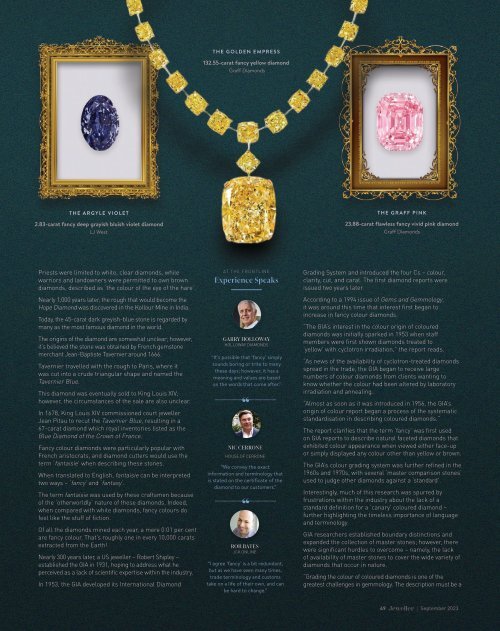Jeweller - September 2023
Create successful ePaper yourself
Turn your PDF publications into a flip-book with our unique Google optimized e-Paper software.
THE GOLDEN EMPRESS<br />
132.55-carat fancy yellow diamond<br />
Graff Diamonds<br />
THE ARGYLE VIOLET<br />
2.83-carat fancy deep grayish bluish violet diamond<br />
LJ West<br />
THE GRAFF PINK<br />
23.88-carat flawless fancy vivid pink diamond<br />
Graff Diamonds<br />
Priests were limited to white, clear diamonds, while<br />
warriors and landowners were permitted to own brown<br />
diamonds, described as ‘the colour of the eye of the hare’.<br />
Nearly 1,000 years later, the rough that would become the<br />
Hope Diamond was discovered in the Kollour Mine in India.<br />
Today, the 45-carat dark greyish-blue stone is regarded by<br />
many as the most famous diamond in the world.<br />
The origins of the diamond are somewhat unclear; however,<br />
it’s believed the stone was obtained by French gemstone<br />
merchant Jean-Baptiste Tavernier around 1666.<br />
Tavernier travelled with the rough to Paris, where it<br />
was cut into a crude triangular shape and named the<br />
Tavernier Blue.<br />
This diamond was eventually sold to King Louis XIV;<br />
however, the circumstances of the sale are also unclear.<br />
In 1678, King Louis XIV commissioned court jeweller<br />
Jean Pitau to recut the Tavernier Blue, resulting in a<br />
67-carat diamond which royal inventories listed as the<br />
Blue Diamond of the Crown of France.<br />
Fancy colour diamonds were particularly popular with<br />
French aristocrats, and diamond cutters would use the<br />
term ‘fantaisie’ when describing these stones.<br />
When translated to English, fantaisie can be interpreted<br />
two ways – ‘fancy’ and ‘fantasy’.<br />
The term fantaisie was used by these craftsmen because<br />
of the ‘otherworldly’ nature of these diamonds. Indeed,<br />
when compared with white diamonds, fancy colours do<br />
feel like the stuff of fiction.<br />
Of all the diamonds mined each year, a mere 0.01 per cent<br />
are fancy colour. That’s roughly one in every 10,000 carats<br />
extracted from the Earth!<br />
Nearly 300 years later, a US jeweller – Robert Shipley –<br />
established the GIA in 1931, hoping to address what he<br />
perceived as a lack of scientific expertise within the industry.<br />
In 1953, the GIA developed its International Diamond<br />
AT THE FRONTLINE<br />
Experience Speaks<br />
FP<br />
ADVERTISEMENT<br />
GARRY HOLLOWAY<br />
HOLLOWAY DIAMONDS<br />
“It’s possible that ‘fancy’ simply<br />
sounds boring or trite to many<br />
these days; however, it has a<br />
meaning and values are based<br />
on the words that come after."<br />
NIC CERRONE<br />
HOUSE OF CERRONE<br />
“We convey the exact<br />
information and terminology that<br />
is stated on the certificate of the<br />
diamond to our customers.”<br />
ROB BATES<br />
JCK ONLINE<br />
“I agree ‘fancy’ is a bit redundant,<br />
but as we have seen many times,<br />
trade terminology and customs<br />
take on a life of their own, and can<br />
be hard to change.”<br />
Grading System and introduced the four Cs – colour,<br />
clarity, cut, and carat. The first diamond reports were<br />
issued two years later.<br />
According to a 1994 issue of Gems and Gemmology,<br />
it was around this time that interest first began to<br />
increase in fancy colour diamonds.<br />
“The GIA’s interest in the colour origin of coloured<br />
diamonds was initially sparked in 1953 when staff<br />
members were first shown diamonds treated to<br />
‘yellow’ with cyclotron irradiation,” the report reads.<br />
“As news of the availability of cyclotron-treated diamonds<br />
spread in the trade, the GIA began to receive large<br />
numbers of colour diamonds from clients wanting to<br />
know whether the colour had been altered by laboratory<br />
irradiation and annealing.<br />
“Almost as soon as it was introduced in 1956, the GIA’s<br />
origin of colour report began a process of the systematic<br />
standardisation in describing coloured diamonds.”<br />
The report clarifies that the term ‘fancy’ was first used<br />
on GIA reports to describe natural faceted diamonds that<br />
exhibited colour appearance when viewed either face-up<br />
or simply displayed any colour other than yellow or brown.<br />
The GIA’s colour grading system was further refined in the<br />
1960s and 1970s, with several ‘master comparison stones’<br />
used to judge other diamonds against a ‘standard’.<br />
Interestingly, much of this research was spurred by<br />
frustrations within the industry about the lack of a<br />
standard definition for a ‘canary’ coloured diamond –<br />
further highlighting the timeless importance of language<br />
and terminology.<br />
GIA researchers established boundary distinctions and<br />
expanded the collection of master stones; however, there<br />
were significant hurdles to overcome – namely, the lack<br />
of availability of master stones to cover the wide variety of<br />
diamonds that occur in nature.<br />
“Grading the colour of coloured diamonds is one of the<br />
greatest challenges in gemmology. The description must be a<br />
49 | <strong>September</strong> <strong>2023</strong>

















